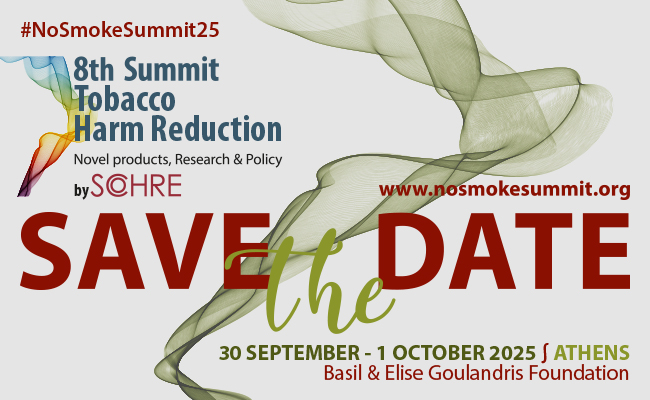Professors Angelos Hatzakis and Ignatios Ikonomidis chaired an interesting session titled “The Case of Nicotine Use in Greece – Behavioural and Clinical Data,” exploring the use of tobacco and tobacco harm reduction (THR) products from these two key perspectives. Dr. Konstantinos Kesanopoulos highlighted concerning trends in youth smoking among adolescents aged 13 to 15 years old, noting an increase in tobacco and e-cigarette usage, a decline in cessation efforts, and the ineffectiveness of anti-tobacco messaging, while stressing the need for targeted intervention programs and innovative strategies to combat these issues. Dr. Kallirrhoe Kourea presented the effects of heat-not-burn products, electronic cigarettes, and combustible smoke on endothelial glycocalyx, revealing that electronic cigarettes had a neutral effect, while heat-not-burn products showed slight improvements in larger vessels.
Youth Smoking Trends in Greece: Analysing Adolescent Behaviours and Influences
The first speaker, Dr. Konstantinos Kesanopoulos, focused on a topic of critical importance, “Youth smoking trends in Greece”, specifically among adolescents aged 13 to 15 years old, based on recent findings from the Global Youth Tobacco Survey (GYTS). Dr. Kesanopoulos stressed that smoking among adolescents is not just a public health concern, but a growing epidemic with long-term consequences. The increasing rate of tobacco and electronic cigarettes use, as well as the challenges in cessation efforts, underscore the need for immediate action. Adolescence is a crucial period, when many life-long habits are formed and smoking poses a significant threat, not only to the physical health of young individuals, but also to the well-being of our future society.
The analysis compared data from two key periods, 2013 and 2023; Dr. Kesanopoulos pointed-out the MPOWER implementation in Greece since 2007 and the fulfilling of the majority of targets since 2016.
The study showed a notable increase in overall tobacco use among Greek adolescents, including an increase in the use of electronic cigarettes. The findings suggest that while traditional cigarette smoking has risen slightly, the surge in e-cigarette use is reshaping the landscape of tobacco consumption. These trends call for immediate implementation of prevention programs.
The decline in cessation efforts among young smokers over the past decade is concerning. Fewer adolescents are attempting to quit or expressing a desire to stop smoking, which suggests that smoking cessation campaigns may be losing their effectiveness or appeal.
The data also show modest progress in reducing exposure to secondhand smoke in both domestic and public environments; while fewer adolescents report being exposed to second-hand smoke at home, exposure levels in public places remain high. These statistics suggest that further efforts are needed to protect youth in public spaces where law enforcement may be lacking.
Access to tobacco products among Greek adolescents has receded slightly, with fewer young people successfully purchasing cigarettes from stores and fewer bypassing age restrictions. However, the fact that a large percentage of adolescents can still easily access tobacco products is concerning and calls for stricter enforcement of regulations.
The findings of the study may indicate that public health campaigns have lost some of their effectiveness among adolescents over the past decade; it becomes clear that a revitalization of tobacco prevention messaging is needed, particularly through channels that resonate with younger audiences, such as the social media.
In conclusion, while efforts to restrict access to tobacco and limit secondhand smoke exposure have yielded positive results, the overall increase in tobacco use, particularly in electronic cigarettes consumption, is concerning. The data call for an immediate focus on prevention, education, and cessation support, tailored to the realities of the youth today.
During the vivid discussion that followed the presentation, Dr. Kesanopoulos said that the “official” providers of tobacco products for adolescents are mainly friends and older people, around 18 or 19 years old, cousins for example, who smoke systematically; and, of course, adolescents are picking up cigarettes secretly from their parents. Responding to Prof. Hatzakis’s request for more details on the frame of the study, as well as on the use of heated tobacco products, Dr. Kesanopoulos added that sampling in the study followed the norms set by WHO and the CDC and that 3,288 adolescents from all over the country replied to the questionnaires. Heated products represented 7.9% of tobacco use; surprisingly, heated product use rates were 7.6% among boys and 8.1% among girls. So, it seems that the design of these products is more appealing to girls. As the GYTS methodology should be applied every five years, the researchers hope that they will be able to record the evolution in the use of heated tobacco products. “But if I can insist in one point of my presentation, it is that the results should alarm us in order to take actions for prevention and smoking cessation especially in this particular age group”, Dr. Kesanopoulos said emphatically.
Differential Effects of Heat-Not-Burn, Electronic and Conventional Cigarettes on Endothelial Glycocalyx
Then, Prof. Ikonomidis called Dr.Kallirrhoe Kourea to present her team’s study on the “Differential effects of heat-not-burn, electronic and conventional cigarettes on endothelial glycocalyx.” As Prof. Ikonomidis explained, glycocalyx is a layer of glycoproteins that protects the endothelium. The endothelial cells in the lumen of the vessel protect the vessel from all toxic substances that circulate due to increased blood pressure, lipids, and carbon monoxide. If the glycocalyx is disturbed, then atherosclerosis is initiated.
Referring to the rationale of the study, Dr. Kourea said that heat-not-burn cigarettes (HNBC) and electronic cigarette (Ecig) constitute non-combustible smoking products. Studies report detrimental acute effects on cardiovascular function after use of these novel smoking products. However, the amount of inhaled chemical products, such as nitrosamines and aldehydes, after use of these products is considerably lower than that after conventional tobacco smoking (Tcig). Thus, switching from Tcig to HNBC or Ecig may improve cardiovascular function in the long-term. However, the effect of HNBC and Ecig use on endothelial glycocalyx has not been investigated so far.
In the study, 50 current smokers were randomized to HNBC use (n=25) or to Ecig puffing (n=25), whereas 50 smokers with no intention to quit smoking were used as controls. Smoking status was verified by self-reported smoking burden per day and exhaled carbon monoxide (eCO) concentration measurement [parts per million (ppm)]. The researchers used Glycocheck, a device that performs sublingual microscopy by a dedicated camera, to measure capillaries diameters between 5 and 25 µm, and, most importantly, the perfused boundary regions (PBR) in straight sections of these vessels. The higher the PBR the more damaged the glycocalyx thickness. Exhaled CO, endothelial glycocalyx and blood cotinine were assessed at baseline and after 1 month.
Conventional cigarette smoking further deteriorated endothelial glycocalyx after continuation of smoking for one month. Conversely, smokers switching to Ecig preserved glycocalyx integrity while those who switched to HNBC showed a modest improvement of the glycocalyx integrity in the micro-vessel ranging from 20 to 25 μm. Cotinine levels, which reflect nicotine exposure, were similar between Tcig, HNBC and Ecig groups. Thus, impairment of endothelial glycocalyx in the Tcig group was independent from nicotine consumption and was likely related with greater exposure to toxic emissions, such as CO, after Tcig use than after switching to HNBC or Ecig.
Discussion
Commenting on the study, Professors Ikonomidis and Hatzakis agreed that it was a pioneering study which opens room for longer-term research on many biomarkers, as well as on the association of these longer-term effects with clinical conditions. Prof. Ikonomidis referred to the preliminary results of a multicenter study in 37 countries across Europe that showed good effects on markers of lung function and on some markers of arterial elasticity. The results appear to be in agreement with the Cochrane database, where no adverse cardiac events were seen in HNBC users for a period of about two years, although longer-term studies of five or ten years are actually needed to check the cardiovascular effects. Interestingly, while nicotine levels were similar in combustible cigarette smokers, e-cigarette smokers, and HNBC users, the damage was observed in smokers of combustible cigarettes. So, it’s not nicotine per se that causes the problem, but all the rest toxicants in a combustible cigarette.
Closing the session, Prof. Hatzakis commented that it is important to establish a kind of observatory and repeat the epidemiological studies from time to time. He added that we need more clinical and laboratory research on biomarkers, with long-term studies, and he predicted that the future of this scientific work is going to be very interesting.





